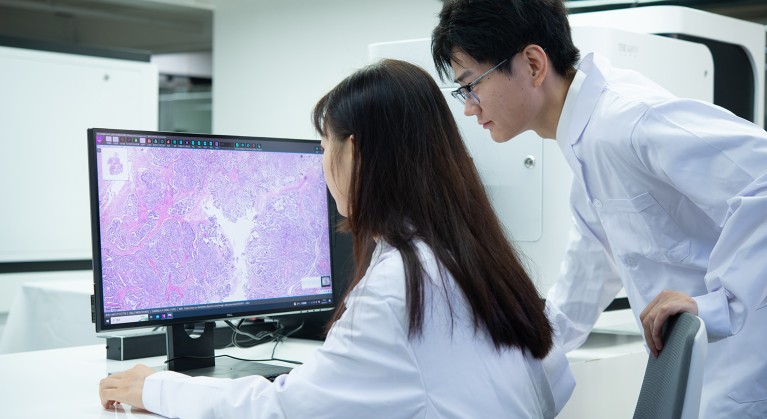
The rapid digitization of histological samples offers many advantages, including preservation of data and artificial-intelligence-aided analysis.
To diagnose diseases accurately, pathologists still typically examine histological samples under the microscope. By leveraging recent advances in artificial intelligence (AI), researchers in China are seeking to enhance diagnostic efficiency.
Pathology, particularly the testing of histological samples in the laboratory, “is the gold standard of clinical diagnosis,” says Yonghong He, a professor and director of the Optical Detection and Imaging Laboratory at the Shenzhen International Graduate School of Tsinghua University, in Shenzhen, China.
Despite this, pathology lags behind other medical techniques in term of digitization. “Other sources of medical data, such as protein and genetic information; and computed tomography and ultrasound images at the organ level, have all been digitized,” says He. “However, the digitization of pathology samples is just getting started in clinical practice.”
Digitization preserves pathological data, eliminating the risk of losing data through of loss or damage of slides. It can also facilitate research and teaching, as well as enable remote diagnosis and intelligent pathology.
The need for speed
Digitizing pathological data includes acquiring high-resolution images using optical microscopy to scan the entire slide of a biological sample. These samples might be obtained from a patient during surgery or through a biopsy. But it’s critical to find ways to do this rapidly, explains He.
“Performing ultrafast scans is key to fueling future clinical applications,” He adds. “The demand in China is so high — up to 5,000 pathology slides per day in tertiary hospitals — that conventional, low-speed scans are not able to cope with it.”
To address this need, his team has teamed up with Shenzhen Shengqiang Technology, a high-tech company established in 2013 that focuses on pathology digitization. Other partners include the Greater Bay Area National Center of Technology Innovation (GBA NCTI) and the Center for Capacity Building and Continuing Education of the National Health Commission. They have been concentrating on three areas: ultrahigh-resolution optical imaging, ultrahigh-precision motion algorithms and highly efficient image-processing algorithms.
The results are promising, says He. “A set of high-precision scans can now be completed in 10 seconds, and we can generate a panorama-like image of samples that can be zoomed in and pinpointed locally, with a clear view of the cell’s fine structure.”
Harnessing AI
The digitization of pathology slides has also enabled researchers to explore the use of AI-assisted diagnostics.
“Once image data has been obtained, AI can come in handy,” explains He. “By detecting cell counts and distinguishing cell morphology, AI can free up pathologists from repetitive and tedious tasks, thus improving their efficiency.”
The diagnostic intelligence of pathologists can also help inform AI algorithms. Pathologists first distinguish between benign and malignant tissues, then between different lesions within tissues. Inspired by this, He’s team designed an efficient and accurate deep-learning architecture called DeepTree that mimics a pathologist’s diagnostic methods, which they verified with lung cancer samples1.
Along with Shengqiang Technology, the team is now integrating AI into diagnostic-aid tools. They are currently focusing on lymph nodes, glomeruli and immunohistochemistry, and are involved in clinical trials with leading hospitals across China.
He believes that digitization and AI can help overcome the uneven distribution of medical resources, enabling better sharing of information and diagnostic capabilities. This is especially important in China, where resources are concentrated in big cities.
“Pathology data could also be combined with other medical activity data for use with AI tech,” adds He.


